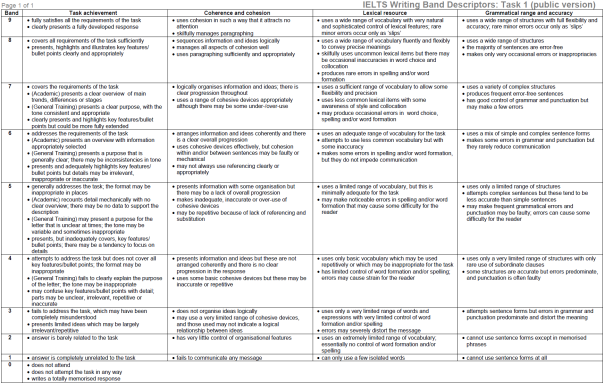
I often get students who need to, for example, improve from 5.5 to 6.5 in writing, but only have a week or two before their exam. At first it sounds a bit like mission impossible, because in such a short time there is very little we can do to improve students grammar and vocabulary. Fortunately for our students, IELTS is not just about correct and varied language.
In this post I’d like to discuss the IELTS Writing Task 1 assessment criteria and its implications for preparing students for the exam. We’ll identify the most common mistakes students make that stop them from getting the desired band, which can at the same time be very easily fixed in a relatively short time. I’ll focus on Task 1 here, because for most students it is something completely new, and can turn out to be quite challenging.
Let’s get started then. Below you can see the assessment criteria (public version – the one the examiners get is super top-secret). You can easily download the public assessment criteria in pdf from for example the official IELTS site. You can click on the image below to enlarge it.
As you can see, there are four criteria, each of which is marked completely independently. That means you could (in theory) get a 9 in LR (Lexical Resource), but only 5 on TA (Task Achievement). The final score for the task is an average of all four criteria. The score is rounded down. This means that TA: 6, CC: 6, LR: 6 and GRA: 7 would give you a 6, while TA: 6, CC: 6, LR: 6 and GRA: 5 would give you 5.5. Of course, TA: 6, CC: 6, LR: 7 and GRA: 7 would add up to 6.5.
It is important to know which band your student needs as this will determine the areas you should focus on in the classes. In most cases (e.g. for visa or study reasons), students need a 6.5. As a result, we’ll focus our attention on the descriptors for band 5, 6 and 7.
In this post, I’ll look at TA first, because:
- students usually don’t know how to approach the task
- the most common mistakes are very easy to fix
- even students whose language is very good, often get low scores on TA
- it’s relatively easy to bring a student up from 5 to 7 in a short time
I crossed out points which refer to IELTS General Training Assessment as we will only focus on the Academic IELTS, which is the format 90% of candidates choose.
When you look at the criteria, decide:
- which two points stop you from getting band 6?
- what is an overview and why is it important?
- what could be classified as irrelevant, inaccurate and inappropriate details?
- how is band 7 specifically better than band 6?
- No data (i.e. no numbers) in the description and/or no overview. The student also focuses too much on detail.
- An overview presents the main or general trends that can be seen in the graph, e.g. Overall, the sales of desktop computers declined significantly during the period. Without an overview, the student will not get band 6
- Inappropriate: any evaluation or personal comments on the data. Irrelevant: data that is not presented, comments which do not relate to the graph. Inaccurate: factual mistakes in the description (e.g. with dates or numbers)
- The overview is clear and there are no inaccurate or inappropriate information as described above in point 3.
How should this inform our teaching?
When checking my students’ writing, I sometimes want to cry when I get a Task 1 which in terms of CC, LR and/or GRA could be easily 7, but the student didn’t include any data. Or there’s no overview. Or the student interprets the data. It’s such a shame, because all these mistakes limit the work to 5 on TA. They’re also very easy to fix. In one of the next posts I’ll show you an example lesson which does exactly that.
Another important point we need to highlight to our students is that they should not focus on all the details. For example, describing what exactly happened in every single year in the graph or chart is not a good idea. Instead, the student should notice the main features of the graph, i.e. the most salient features, such as the high/low points, the starting/end values, the rises and falls, and describe these accordingly.
So, to sum up, in order to get band 6 or 7, the student should:
- present an overview of the main trends (preferably in the conclusion)
- use data accurately
- NOT comment on the data, nor interpret it in any way
- NOT focus on all the details
- notice key features and describe them accordingly
If you’re interested in other tips for IELTS Writing Task 1, you might want to read this post where I discuss the DOs and DONTs of Task 1.
If you have any comments or suggestions, feel free to comment below or drop me a message. For IELTS preparation courses, please click here or Contact me directly.


Thank you!!! Please keep posting posts like this, very helpful! 🙂
Thanks, Lizzie. Will do. This is just a start. There are plenty on the way 🙂 how are you getting on with your IELTS groups?
I’m on my second course now, and things are getting much better, thanks! 🙂
Nice thing, thanks 🙂 Writing Task 1 is the worst thing for my students 🙂
Yes. Usually sts struggle with it, because they have no clue how to approach the task. Once they’re familiar with it, it becomes quite an easy and mechanical task. You don’t need to be a good writer, or have a wide vocabulary to do well here.
That’s exactly the reason they hate it – you don’t need to be a good writer, you need no complicated vocab, only mechanical grammar and sentence structure… so what’s the point? 🙂
I guess it gives those with a head for figures a chance to shine. If you’re going to do science in university you don’t need to write beautiful essays, but you do need to be able to analyse and describe data.
Not defending the task in any way, mind you. Just giving a possible justification for it.
When my sts realise how easy it can be, they actually start to like it a lot 🙂
That.s great
I would like this idea
I really liked this post and I am thank you for the time and effort you provided. I am IELTs candidate and I want to be part with your network, so is there any way that I can register to receive your posts? Thank you so much in advance.
On the right hand side click on the button; Follow the blog. You can also sign up for an on-line IELTS preparation course through my website: http://www.polishyourlanguages.com
Best,
Marek
Thanks for this learning skills, pls how can I join a group to enable me practice, my english skills is very poor and my examination date is fast approaching.
You can follow the blog on the right hand side. You’ll then get all the latest post by email. You can also contact us for private classes at teflreflections@gmail.com
Good luck with the exam!
Thxs. um realy benifited with this………….
You’re welcome
Good job!
cheers
How are you
I need your help to pass in the exam
Best regards
Take a look at the courses we offer here: https://teflreflections.wordpress.com/ielts-courses/
Hi Marek,
Just to let you know that we’ve shortlisted this blog post for this month’s TeachingEnglish blog award and I’ll be making a post about it on today’s TeachingEnglish Facebook page http://www.facebook.com/TeachingEnglish.BritishCouncil, if you’d like to check there for likes and comments.
Best,
Ann
Hi Ann,
Thanks a lot. That’s great news 🙂
Best,
Marek
Is good to have the right tools in different categories. Keep posting messages like this for future teachers who want to teach different ways of learning styles.
I’m glad you have found the post useful, Alberto. If you have any suggestions for future posts, let us know.
I wannt to be ielts passer but i am only high school graduate.i”am qualified to this field?
Reblogged this on ieltsteacherwilliam's Blog.
Reblogged this on Food for Thought.
Thanks for reblogging.
Thank you for this summary–I’ll admit this is my least favourite part of the IELTS as a teacher. I tell students that one approach is to imagine that they’ve been doing a lot of research into a particular topic and now it’s time to present their very busy boss with the results. Of course the boss knows about the topic so doesn’t need any explanation or intrepretation–just a 3 minute summary of the main trends.
This helps maintain focus on the results and keep the writing short, and also gives a real-world example of when we might have to do something similar.
I think identifying the most common mistakes students make in ielts writing task and knowing how to avoid them is the most effective way to jump from band 5.5 to 6 or even higher. With adequate practice, it would be easier for an IELTS taker to acquire the needed band. I practiced a lot using this http://www.ieltspodcast.com/category/ielts-writing-task/ and was able to secure a band 7 on Writing. Finally, I can now apply for a PR!